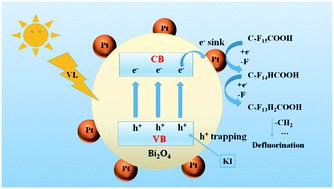当前位置:
X-MOL 学术
›
Environ. Sci.: Water Res. Technol.
›
论文详情
Our official English website, www.x-mol.net, welcomes your feedback! (Note: you will need to create a separate account there.)
Photocatalytic reductive defluorination of perfluorooctanoic acid in water under visible light irradiation: the role of electron donor
Environmental Science: Water Research & Technology ( IF 5 ) Pub Date : 2020-04-06 , DOI: 10.1039/d0ew00205d Wanjun Wang 1, 2, 3, 4, 5 , Yu Chen 1, 2, 3, 4, 5 , Guiying Li 1, 2, 3, 4, 5 , Wenquan Gu 1, 2, 3, 4, 5 , Taicheng An 1, 2, 3, 4, 5
Environmental Science: Water Research & Technology ( IF 5 ) Pub Date : 2020-04-06 , DOI: 10.1039/d0ew00205d Wanjun Wang 1, 2, 3, 4, 5 , Yu Chen 1, 2, 3, 4, 5 , Guiying Li 1, 2, 3, 4, 5 , Wenquan Gu 1, 2, 3, 4, 5 , Taicheng An 1, 2, 3, 4, 5
Affiliation

|
The development of efficient technology for perfluorooctanoic acid (PFOA) treatment has prompted much attention in water environmental fields, due to its global distribution and threats to ecosystems. In this study, a new method for reductive defluorination of PFOA under visible light (VL) was established by using Pt–Bi2O4 as a photocatalyst and KI as an electron donor. The defluorination process in water was found to occur via a photocatalytic reductive pathway, in which the photo-generated e− played the dominant role. The Pt served as a co-catalyst to trap the photo-generated e−, while KI could trap photo-generated h+ to suppress the undesired e−–h+ recombination, which cooperatively enhanced the defluorination efficiency. Along with PFOA reduction, very limited amounts of short-chain perfluorocarboxylic acid intermediates were generated, all of which could be further degraded to inorganic ions, and the total recovery of fluorine could reach 99% after 6 h of irradiation. The system also possesses high photostability, since the photocatalyst surface remained clean during the degradation. Finally, a decomposition pathway of stepwise removal of CF2 units was proposed in detail. As a proof-of-concept, the VL/Pt–Bi2O4/KI system not only shows potential for sustainable and “green” removal of PFOA in water, but may also find applications in the treatment of various refractory organic pollutants in water using solar energy.
中文翻译:

可见光照射下水中全氟辛酸的光催化还原脱氟:电子给体的作用
由于全氟辛酸(PFOA)的全球分布和对生态系统的威胁,有效的全氟辛酸(PFOA)处理技术的发展引起了水环境领域的广泛关注。在这项研究中,通过使用Pt–Bi 2 O 4作为光催化剂和KI作为电子供体,建立了一种在可见光(VL)下PFOA还原脱氟的新方法。在水中的脱氟方法被发现发生经由光催化还原途径,其中所述光经产生的E -发挥主导作用。将Pt用作助催化剂以捕获光经产生的E - ,而KI可以捕集光生ħ +抑制不希望的ë - -h+重组,共同提高了脱氟效率。随着PFOA的减少,产生了数量非常有限的短链全氟羧酸中间体,所有这些中间体都可以进一步降解为无机离子,照射6 h后氟的总回收率可以达到99%。该体系还具有很高的光稳定性,因为光催化剂表面在降解过程中保持清洁。最后,详细提出了逐步去除CF 2单元的分解途径。作为概念验证,VL / Pt–Bi 2 O 4/ KI系统不仅显示出可持续和“绿色”去除水中PFOA的潜力,而且还可发现其在利用太阳能处理水中各种难降解有机污染物方面的应用。
更新日期:2020-04-06
中文翻译:

可见光照射下水中全氟辛酸的光催化还原脱氟:电子给体的作用
由于全氟辛酸(PFOA)的全球分布和对生态系统的威胁,有效的全氟辛酸(PFOA)处理技术的发展引起了水环境领域的广泛关注。在这项研究中,通过使用Pt–Bi 2 O 4作为光催化剂和KI作为电子供体,建立了一种在可见光(VL)下PFOA还原脱氟的新方法。在水中的脱氟方法被发现发生经由光催化还原途径,其中所述光经产生的E -发挥主导作用。将Pt用作助催化剂以捕获光经产生的E - ,而KI可以捕集光生ħ +抑制不希望的ë - -h+重组,共同提高了脱氟效率。随着PFOA的减少,产生了数量非常有限的短链全氟羧酸中间体,所有这些中间体都可以进一步降解为无机离子,照射6 h后氟的总回收率可以达到99%。该体系还具有很高的光稳定性,因为光催化剂表面在降解过程中保持清洁。最后,详细提出了逐步去除CF 2单元的分解途径。作为概念验证,VL / Pt–Bi 2 O 4/ KI系统不仅显示出可持续和“绿色”去除水中PFOA的潜力,而且还可发现其在利用太阳能处理水中各种难降解有机污染物方面的应用。



























 京公网安备 11010802027423号
京公网安备 11010802027423号